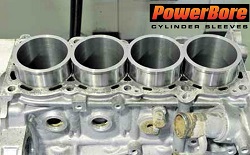Installing cylinder sleeves or cylinder liners correctly will take you some practice, no question. It’s a somewhat cumbersome process that requires heat in addition to tools, and knowing how to dial everything in to create the right fit is a skill.
Before we go any further, we will tell you the WRONG WAY TO INSTALL CYLINDER SLEEVES. Many old timers used to (and unfortunately still do) place a block of wood on top of the sleeve and hammer it into the cylinder. DO NOT DO THIS. Dimensions, interference fit, and clearance are all critical to running your high-performance engine. You are likely to mess something up using this method and cause yourself more harm than good. Can you get a sleeve into your engine this way? Yes. Do you want to? No.
Now, here’s the right way to install cylinder sleeves. Before even beginning to install your sleeves, be sure that your cylinder is bored to the correct dimensions to accept the sleeve. This is critical adjustment must be done before installing cylinder sleeves. Interference fit will vary based on your material, as aluminum has greater thermal expansion than iron. The industry standard is to use a .004” fit for an aluminum block and a .002” — .004” fit for an iron block depending on the size of the bore and whether the engine is setup to run wet or dry sleeves. If you go beyond .004” you run the risk of distorting the cylinder and creating the potential for loss of compression and blowby.
Establishing the correct fit is crucial, as this fit will hold the cylinder in place when the engine is operating and will allow the cylinder to cool at the optimal rate.
Now you’re ready to install the sleeve
Remove all parts such as nuts and bolts or other obstructions from the engine cylinder. This might sound obvious, but some folks have to learn everything the hard way and blow something up before they figure out how to do a job right.
The block should be heated up to 400 degrees and held at temperature for an hour to allow uniform heating of the cylinder. This causes the cylinder to expand slightly, and the sleeve should drop in. If the sleeve has ports, you will need to turn the sleeve to ensure that the ports line up. Once the block is cooled, ports may need to be blended and chamfered with a grinder so that there is no mismatch between the cylinder wall and the sleeve. If you have ports that have tight entry angles machined into them, then you need a machinist to install your sleeves.
Certain blocks, usually with wet sleeves, allow for sleeves to be finished (honed) prior to installation, and some must be honed in the block. If you are installing cylinder sleeves that have not been finish-honed, then they must be honed to allow for correct piston clearance.
Finally, you’ll likely want to deck off the top of the cylinder to ensure that the head gasket will seat correctly and seal.
A note about Wet Liners…
If you’re building or rebuilding an engine that has wet sleeves or wet cylinder liners, likely a diesel engine, then interference fit is not a major concern. Most such cylinder liners are meant for a slip fit installation, and many are honed to specification prior to being installed in the block. If a sleeve is a slip fit, then the critical area you need to pay attention to is the counterbore. If the counterbore is not machined to accept the sleeve flange, the sleeve will not fit correctly.

